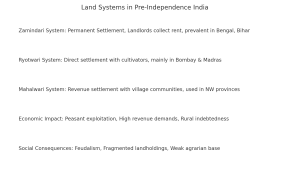
27 Jul Land System and its Changes in Indian Economy Pre-Independence Era
Land System and Its Changes in Indian Economy – Pre-Independence Era
The land revenue systems implemented by the British in pre-independence India had a profound and long-lasting impact on India’s agrarian structure and rural economy. Understanding the Zamindari, Ryotwari, and Mahalwari systems—along with their economic and social implications—is essential for aspirants preparing for the UPSC CSE Economics Optional Paper 2.
📊 Infographic – Land Systems in Pre-Independence India

land systems preindependence era
🧠 Mind Map – Overview of Colonial Land Systems
land_systems_preindependence_mindmap
1. Introduction to Colonial Land Revenue Systems
Land revenue was the primary source of income for the British administration. To maximize revenue and maintain political control, the British introduced exploitative systems of land tenure that transformed the Indian rural landscape and economy. These land systems fundamentally changed land ownership, cultivation practices, and agrarian relations.
2. Zamindari System (Permanent Settlement)
2.1 Overview
- Introduced in 1793 by Lord Cornwallis in Bengal, Bihar, and Orissa.
- Recognized zamindars (landlords) as landowners who would collect rent from peasants.
- Revenue demand was fixed in perpetuity – i.e., permanent settlement.
2.2 Features
- Zamindars acted as intermediaries between the state and peasants.
- If zamindars failed to pay revenue, their land could be auctioned.
- Created a class of absentee landlords with little incentive for agricultural investment.
2.3 Economic Impact
- Increased burden on peasants, often leading to debt and landlessness.
- Low agricultural productivity due to lack of investment and care.
- Neglected irrigation and modernization due to fixed rent and landlord apathy.
3. Ryotwari System
3.1 Overview
- Implemented in Madras, Bombay, parts of Assam and Berar.
- Introduced by Thomas Munro and Captain Read.
- Revenue was directly settled with the cultivator (ryot).
3.2 Features
- No intermediaries – cultivators were recognized as proprietors of land.
- Revised periodically based on land productivity and crops.
- Peasants were individually responsible for revenue payment.
3.3 Economic Impact
- Though more direct, revenue rates were high and extractive.
- Failure to pay led to land loss and peasant distress.
- Led to rural indebtedness and emergence of moneylenders.
4. Mahalwari System
4.1 Overview
- Introduced in NW Provinces (U.P., Punjab), later in parts of Central India.
- Developed by Holt Mackenzie and modified by William Bentinck.
- Revenue settlement was done with entire village communities (mahals).
4.2 Features
- The village headmen or elders were responsible for payment.
- Land was periodically assessed and revenue demand revised.
- System was complex and required collective responsibility.
4.3 Economic Impact
- Though community-based, it was still burdened by high taxes.
- Fostered elite control and local despotism in some areas.
- Insufficient to improve agriculture due to limited state support.
5. Comparative Summary of Land Revenue Systems
| System | Introduced In | Main Region | Key Feature |
|---|---|---|---|
| Zamindari | 1793 | Bengal, Bihar, Orissa | Intermediary landlords with permanent settlement |
| Ryotwari | 1820s | Madras, Bombay | Direct settlement with cultivators (ryots) |
| Mahalwari | 1830s | Uttar Pradesh, Punjab | Settlement with village communities (mahals) |
6. Broader Economic & Social Consequences
- Peasant Exploitation: All systems focused on maximizing revenue, not agricultural development.
- Land Alienation: Frequent land loss by peasants due to non-payment.
- Indebtedness: Rise of moneylenders and usurious credit practices.
- Famines: Neglect of food security and rural distress led to repeated famines.
- Fragmentation: Over generations, landholdings became smaller and uneconomical.
7. Peasant Resistance & Nationalist Critique
- Indigo Revolt (1859-60): Against indigo planters in Bengal.
- Deccan Riots (1875): Peasants rebelled against moneylenders in Maharashtra.
- Congress Critique: Leaders like Dadabhai Naoroji and R.C. Dutt condemned extractive policies.
Dadabhai Naoroji called the land revenue system a “bleeding wound” for Indian agriculture, as it drained peasant incomes.
8. Legacy and Post-Independence Reforms
- Post-1947 land reforms were a direct response to colonial land injustice.
- Abolition of Zamindari was prioritized by most Indian states.
- Land redistribution, tenancy reforms, and ceiling laws aimed to democratize land access.
📚 Previous Year Questions (PYQs) – UPSC CSE Economics
- Explain the impact of the Zamindari system on agrarian structure in colonial India. (UPSC 2021)
- Compare and contrast the Ryotwari and Mahalwari systems. How did they affect rural society? (UPSC 2019)
- Discuss the colonial revenue systems and their role in agrarian distress. (UPSC 2018)
🔮 Probable Questions for Upcoming UPSC Mains & Prelims
- “The British land revenue systems institutionalized inequality.” Discuss with examples.
- How did the Mahalwari system differ in its implementation and outcomes from the Zamindari system?
- Evaluate the role of peasant movements in challenging the colonial agrarian order.
- Discuss the colonial legacy of land systems in shaping India’s post-independence land reforms.




No Comments